If I asked you to name a destination that well-heeled denizens of New York City escape to on the weekend, what would you say? The Hamptons? The Hudson Valley? Greenwich, CT? All good answers. But one that might not be on your radar is Bucks County, PA. Nestled in an elbow of the Delaware River, the county is just north of Philadelphia, 75 miles from Manhattan and about four hours south of Saratoga Springs, and it’s been drawing visitors to has gorgeous countryside, quaint towns, colonial-era historic sites and bustling arts scene for more than a century. In fact, in the 1930s, ’40s and ’50s, Bucks County was home to so many cultural bigwigs—including Pulitzer- and Nobel Prize- and Tony Award-winners, some homegrown (Margaret Mead, James A. Michener), others transplanted (Pearl S. Buck, Dorothy Parker, Jean Toomer, Oscar Hammerstein II, Stephen Sondheim, George Nakashima)—that the media began referring to the area as the Genius Belt. Did I mention that I grew up there?
A Little History
Pennsylvania was founded by William Penn on land granted to him in 1681 by Charles II to pay off a debt. Bucks County was one of three original counties established by Penn in 1682, and he built a country home there, Pennsbury Manor, on the banks of the Delaware near Morrisville. Penn was a Quaker, and the new colony quickly became a haven for members of the Society of Friends. The group’s egalitarian beliefs and commitment to social justice would leave a lasting mark on the area.
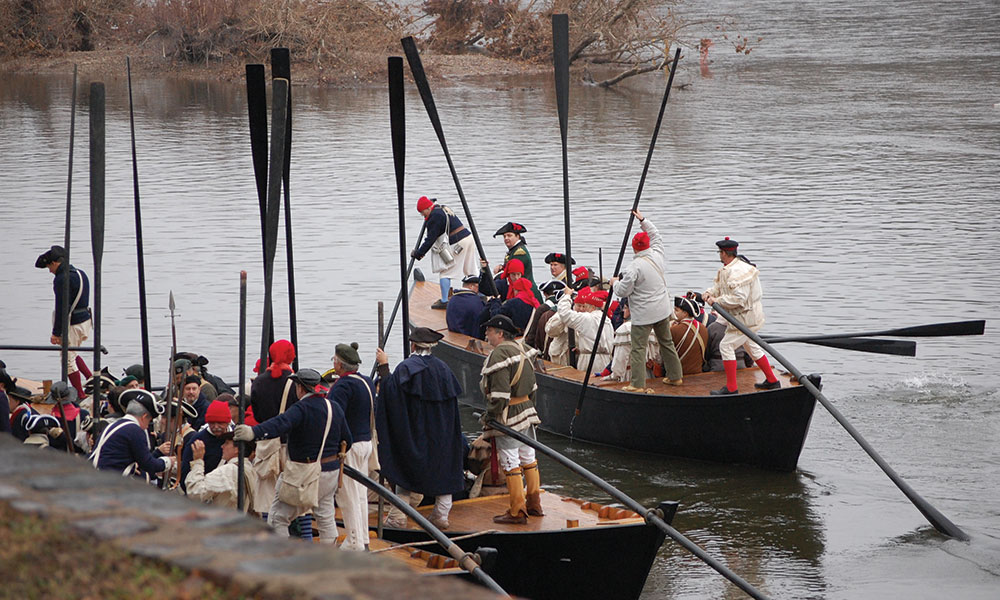
The region’s most significant historical site commemorates a rare, sleepless night for America’s first Commander in Chief, George Washington: December 25, 1776, when he led his troops across the ice-clogged Delaware River to mount a surprise attack on Hessian mercenaries holed up in Trenton, NJ, a turning point in the Revolutionary War. Washington Crossing Historic Park, the site of the continental troops’ embarkation, features 13 historic buildings and a visitor center, where you can study a copy of Emanuel Leutze’s iconic 1851 painting of the crossing. Each Christmas, the park also stages a reenactment. This patriotic holiday tradition (since 1952) features hundreds of costumed history buffs braving the Delaware in 45-foot-long Durham boats—and you can apply to join them! During my teen years, the role of Washington was played by Olympic bronze-medalist rower Jack Kelly, who, oddly enough, did no rowing (a nod to historical authenticity, I suppose). Clearly, Jack’s sister, Grace, wasn’t the only Philadelphia Kelly bitten by the acting bug!
For a more somber and solitary meditation on the continuing struggle for freedom in these United States, I recommend a visit to Mount Gilead African Methodist Episcopal Church (now Mount Gilead Community Church) in Buckingham, a mountaintop house of worship founded in 1822 by former slaves. The existing 32-by-52-foot stone sanctuary, built in 1852, was a station on the Underground Railroad, and the local Quakers, dedicated abolitionists, allowed the fugitives to build a community nearby.
Concrete Castles
I grew up in Doylestown, PA, the county seat, an eminently walkable, picture-postcard town The New York Times has described as “a showcase of American architecture, with stately Federal-style brick buildings on Lawyers’ Row and plenty of gracious Queen Anne, Second Empire and Italianate homes.” The town’s most renowned buildings, however, are a little more…unique. And they were all built by the same man.
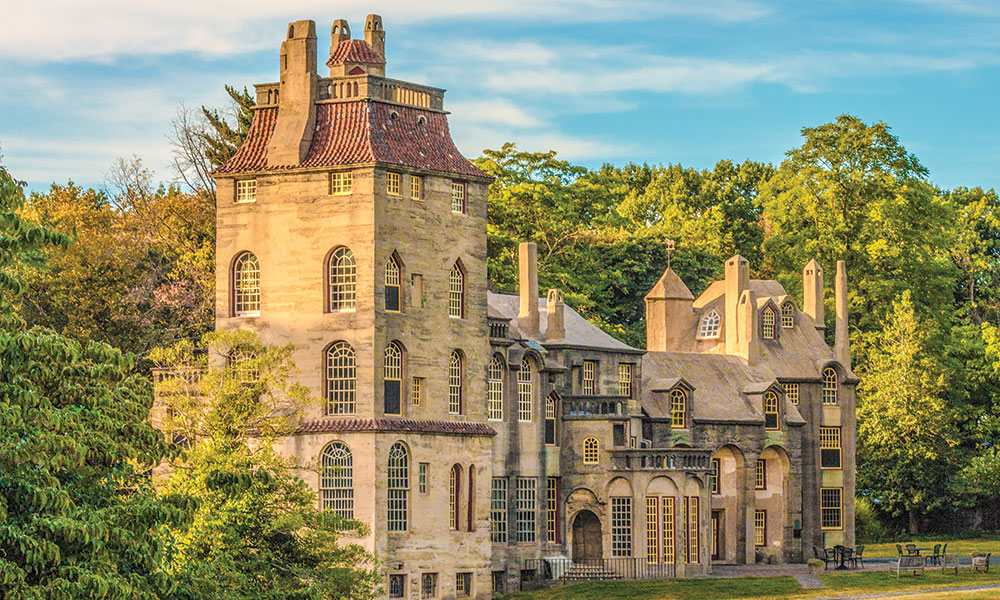
Born in Doylestown in 1856, Henry Chapman Mercer was a Harvard-educated archaeologist, a millionaire (by birth) and a lifelong bachelor who traveled extensively throughout Europe during his teens, 20s and 30s. Convinced that the Industrial Revolution was wiping out traditional handicrafts and artisanship, Mercer began feverishly socking away pre-industrial tools for posterity. To house his collection, which would grow to include close to 50,000 items, Mercer erected a fortress of poured-in-place, reinforced concrete. Opened in Downtown Doylestown in 1916, the Mercer Museum is packed to the rafters with tools used in dozens of trades—from blacksmithing to basket weaving to watchmaking—and its six-story atrium is hung with sleighs, whaling boats, carriages, a Conestoga wagon and even an early fire engine.
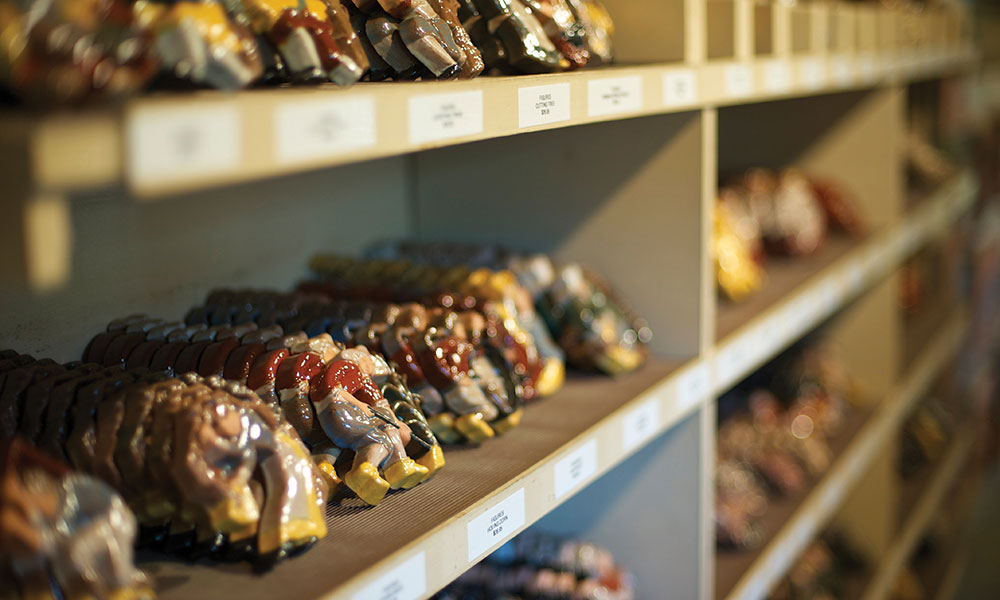
Mercer was such a fan of concrete, he even poured himself a home. Fonthill, a mile north of the museum, is a charmingly eccentric concrete castle—it has 44 rooms, 32 staircases and 18 fireplaces built without plans—that mingles Medieval, Gothic and Byzantine styles. The Bucks County Historical Society offers tours and hosts events at Fonthill throughout the year; the holiday season and candlelight tours (reservations required) are particularly enchanting. If Mercer’s extensive use of decorative tile catches your eye, be sure to check out The Moravian Pottery and Tile Works next door, which he opened in 1898, and where visitors can watch Mercer-designed tiles being made today.
A Bohemian Crossroads
Ten miles east of Doylestown, on the banks of the Delaware, you’ll find New Hope, the county seat’s bohemian sister. As the hub of the arts colony that formed in Bucks County around the turn of the 20th century, New Hope has long had a reputation for welcoming creative and unconventional types, including painters, poets, musicians, designers and craftspeople. The town has had a vibrant LGBTQ community since long before the Stonewall Riots and is a favorite pit stop for bikers.
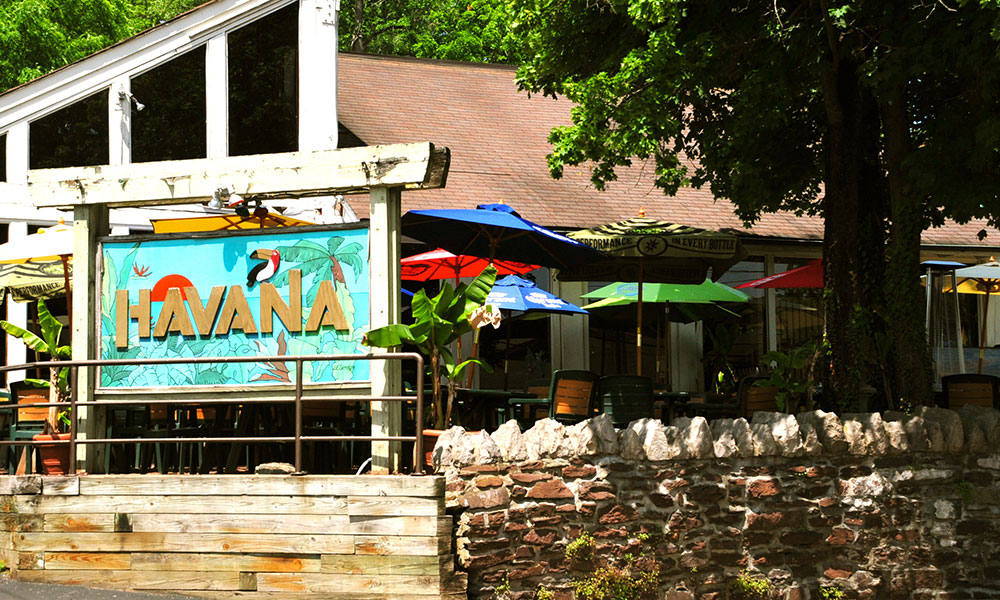
The bucolic scenery and lively arts scene make New Hope a popular getaway, as does its eclectic retail mix: antiques showrooms, bookstores, art galleries, head shops and boutiques featuring crafts, fashion, jewelry and more than a bit of kitsch. (Think: Provincetown without the beach.) The town also boasts an enticing selection of restaurants and watering holes. Marsha Brown serves up Creole cuisine in the soaring sanctuary of an 1800s Presbyterian church; Sprig & Vine offers an inventive plant-based menu; and John & Peter’s and Havana, long-running New Hope staples, are your headquarters for live music.
Climb to the top of Bowman’s Hill Tower, a slender, 125-foot stone spire (erected on the site of a lookout used by Washington’s troops) just south of town, and you’ll see New Hope’s history as a commercial crossroads laid out before you: the broad Delaware, the steel-truss bridge (site of a former ferry) leading to New Jersey, the Delaware Canal (now a state park), and the tracks of the now defunct North-East Pennsylvania Railroad. Today, visitors can board vintage 1920s train cars and take a scenic ride along a portion of those rails courtesy of the New Hope & Ivyland Railroad.
B&B (Bed and Broadway)
The river town’s skyline is dominated by the hulking form of a 1790 gristmill. The shuttered New Hope Mill, from which the burg of New Hope takes its name, was reborn in 1939 as Bucks County Playhouse, one of the nation’s most storied regional theaters, where more than a few Broadway-bound shows have premiered over the years, and where Robert Redford, Angela Lansbury, Liza Minnelli, Bernadette Peters, Tyne Daly, Audra McDonald and a host of other marquee performers have all trod the boards.
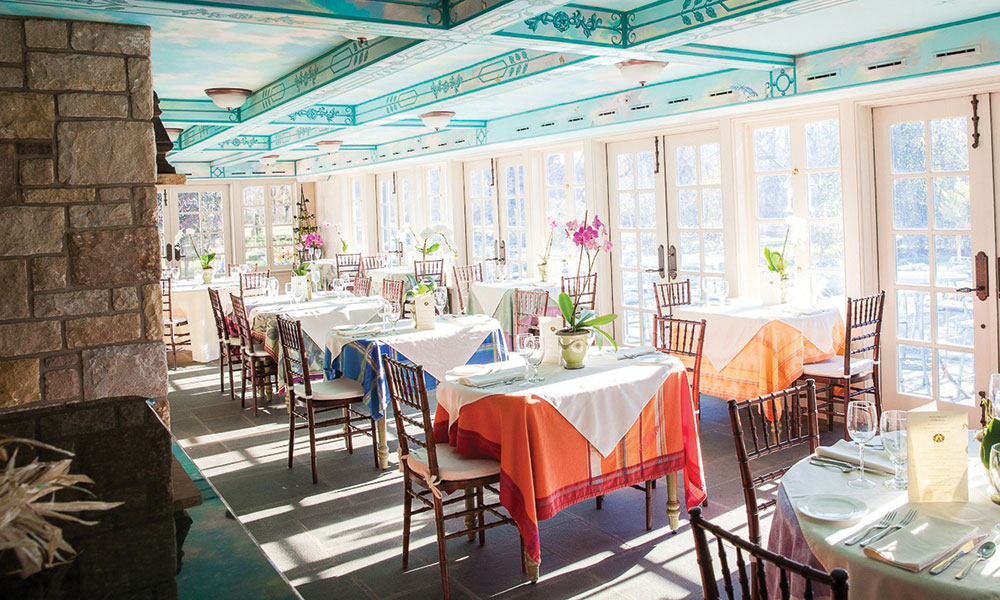
Devotees of the stage could actually spend their entire Bucks County visit marinating in theater history, booking a stay at The Inn at Barley Sheaf Farm, a 1740s farmhouse in Holicong and the longtime home of Pulitzer-winning playwright George S. Kaufman, who hosted luminaries including Moss Hart, the Marx Brothers and Lillian Hellman at the place he cheekily called “Cherchez La Farm.” Another option is Highland Farm, a Doylestown bed-and-breakfast once owned by lyricist Oscar Hammerstein II (another Pulitzer winner), who penned Oklahoma!’s “Oh, What a Beautiful Mornin’” on the front porch.
Even if you’re not a theater buff, a stay in one of the area’s dozens of historic inns and B&Bs is de rigueur. Take it from Aaron Burr: After slaying Alexander Hamilton in their legendary 1804 pistol duel, Burr didn’t go to Disneyland; he spent a week hiding out in a New Hope tavern.
Additional Attractions
Follow the advice of pop star P!NK, perhaps Doylestown’s most famous native, and “raise your glass.” Bucks County is wine country. Devise a sipping itinerary with the help of the Bucks County Wine Trail map or leave the planning (and driving) to someone else and book an afternoon of winery visits with Tastings & Tours.

If your taste in liquid-based activities runs to the more immersive, the leisurely pace of the Delaware makes its waters ideal for tubing in the summer months. Bucks County River Country in Point Pleasant will outfit you with inner tubes, shuttle you to a “put-in” point upriver and leave you to float down the Delaware with friends for a lazy few hours.
If you’re traveling with youngsters—and tubing and sightseeing haven’t worn them out—count on Sesame Place in Langhorne to get the job done with rides, a water park and the thrill of meeting all of their favorite Sesame Street characters. In the end, Bucks County is a lot like Sesame Street: a place where getting along with others is encouraged and diversity is not just embraced but celebrated.


